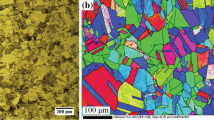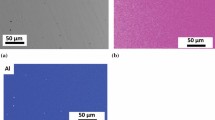Abstract
In this paper, microstructure and texture development in a Fe–24Ni–0.3C metastable austenitic steel processed by accumulative roll bonding (ARB) and subsequent annealing was studied. Microstructural observations and crystallographic analysis were carried out by FE-SEM/EBSD. The results showed that elongated ultrafine-grained austenite having 300 nm in thickness surrounded by high angle boundaries was obtained after 6 cycles of the ARB process. It was found that 1-cycle ARB-processed specimen exhibited Copper ({112} 〈111〉) component as main texture, while by increasing the number of ARB cycles, it deviated to S component ({123} 〈634〉) at 2 cycles or Brass component ({110} 〈112〉) at 6-cycle. Annealing of 6-cycle ARB-processed specimen at 873 K for 1.8 ks resulted in the formation of an austenite with mean grain size of 2.5 µm having strong Cube recrystallization texture ({100} 〈001〉).










Similar content being viewed by others
References
Valiev RZ, Zehetbauer MJ, Estrin Y, Höppel HW, Ivanisenko Y, Hahn H, Wilde G, Roven HJ, Sauvage X, Langdon TG (2007) The innovation potential of bulk nanostructured materials. Adv Eng Mater 9:527–533
Tsuji N (2007) Unique mechanical properties of nanostructured metals. J Nanosci Nanotechnol 7:3765–3770
Saito Y, Tsuji N, Utsunomiya H, Sakai T (1999) Novel ultra-high straining process for bulk materials—development of the accumulative roll-bonding (ARB) process. Acta Mater 47:579–583
Valiev RZ, Krasilnikov NA, Tsenev NK (1991) Plastic deformation of alloys with submicron-grained structure. Mater Sci Eng A 137:35–40
Horita Z, Smith DJ, Furukawa M, Nemoto N, Valiev RZ, Langdon TG (1996) An investigation of grain boundaries in submicrometer-grained Al–Mg solid solution alloys using high-resolution electron microscopy. J Mater Res 11:1880–1890
Richert M, Liu Q, Hansen N (1999) Microstructural evolution over a large strain range in aluminium deformed by cyclic-extrusion–compression. Mater Sci Eng A 260:275–283
Park KT, Kwon HJ, Kim WJ, Kim YS (2001) Microstructural characteristics and thermal stability of ultrafine grained 6061 Al alloy fabricated by accumulative roll bonding process. Mater Sci Eng A 316:145–152
Slamova M, Homola P, Karlik M (2007) Thermal stability of twin-roll cast Al–Fe–Mn–Si sheets accumulative roll bonded at different temperatures. Mater Sci Eng A 462:106–110
Huang X, Tsuji N, Hansen N, Minamino Y (2002) Microtexture of lamellar structures in Al heavily deformed by accumulative roll-bonding (ARB). Mater Sci Forum 408–412:715–720
Kim HW, Kang SB, Tsuji N, Minamino Y (2005) Deformation textures of AA8011 aluminum alloy sheets severely deformed by accumulative roll bonding. Metall Mater Trans A 36:3151–3163
Kamikawa N, Tsuji N, Huang X, Hansen N (2006) Quantification of annealed microstructures in ARB processed aluminum. Acta Mater 54:3055–3066
Chowdhury SG, Dutta A, Ravikumar B, Kumar A (2006) Textural evolution during accumulative roll bonding of an Al–Li alloy. Mater Sci Eng A 428:351–357
Huang CX, Yang G, Wang C, Zhang ZF, Wu SD (2011) Mechanical behaviors of ultrafine-grained 301 austenitic stainless steel produced by Equal-Channel Angular Pressing. Metall Mater Trans A 42A:2061–2071
Hansen N, Juul Jensen D (1994) Grain subdivision during deformation of polycrystalline aluminum. Mater Sci Forum 156–157:1211–1218
Tsuji N, Saito Y, Utsunomiya H, Tanigawa S (1999) Ultra-fine grained bulk steel produced by accumulative roll-bonding (ARB) process. Scripta Mater 40:795–800
Hansen N, Juul Jensen D (1999) Development of microstructure in FCC metals during cold work. Philos Trans R Soc Lond A 357:1447–1469
Hansen N (2001) New discoveries in deformed metals. Metall Mater Trans A 32A:2917–2935
Leffers T, Ray RK (2009) The brass-type texture and its deviation from the copper-type texture. Prog Mater Sci 54:351–396
Humphreys FJ, Hatherly M (2004) Recrystallization and related annealing phenomena. Elsevier, Boston
Acknowledgements
This study was done during Hamidreza Jafarian’s stay in Dept. of Materials Science & Engineering Kyoto University, which was supported by the Ministry of Science, Research and Technology (MSRT) of Iran. The support is gratefully appreciated.
Author information
Authors and Affiliations
Corresponding author
Rights and permissions
About this article
Cite this article
Jafarian, H., Eivani, A. Texture development and microstructure evolution in metastable austenitic steel processed by accumulative roll bonding and subsequent annealing. J Mater Sci 49, 6570–6578 (2014). https://doi.org/10.1007/s10853-014-8254-8
Received:
Accepted:
Published:
Issue Date:
DOI: https://doi.org/10.1007/s10853-014-8254-8




